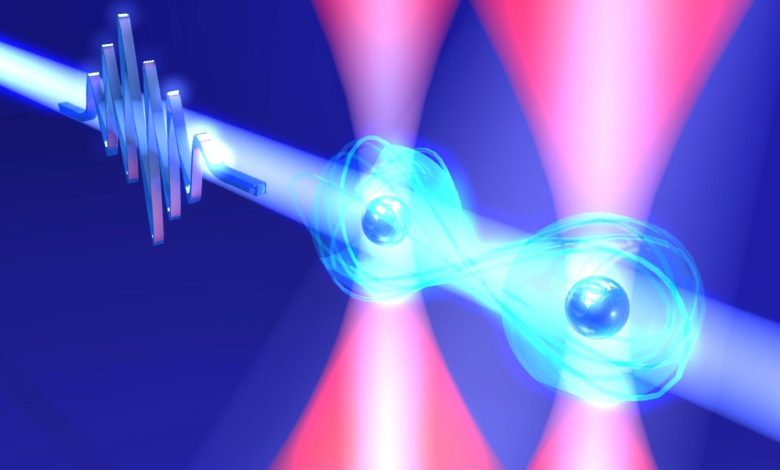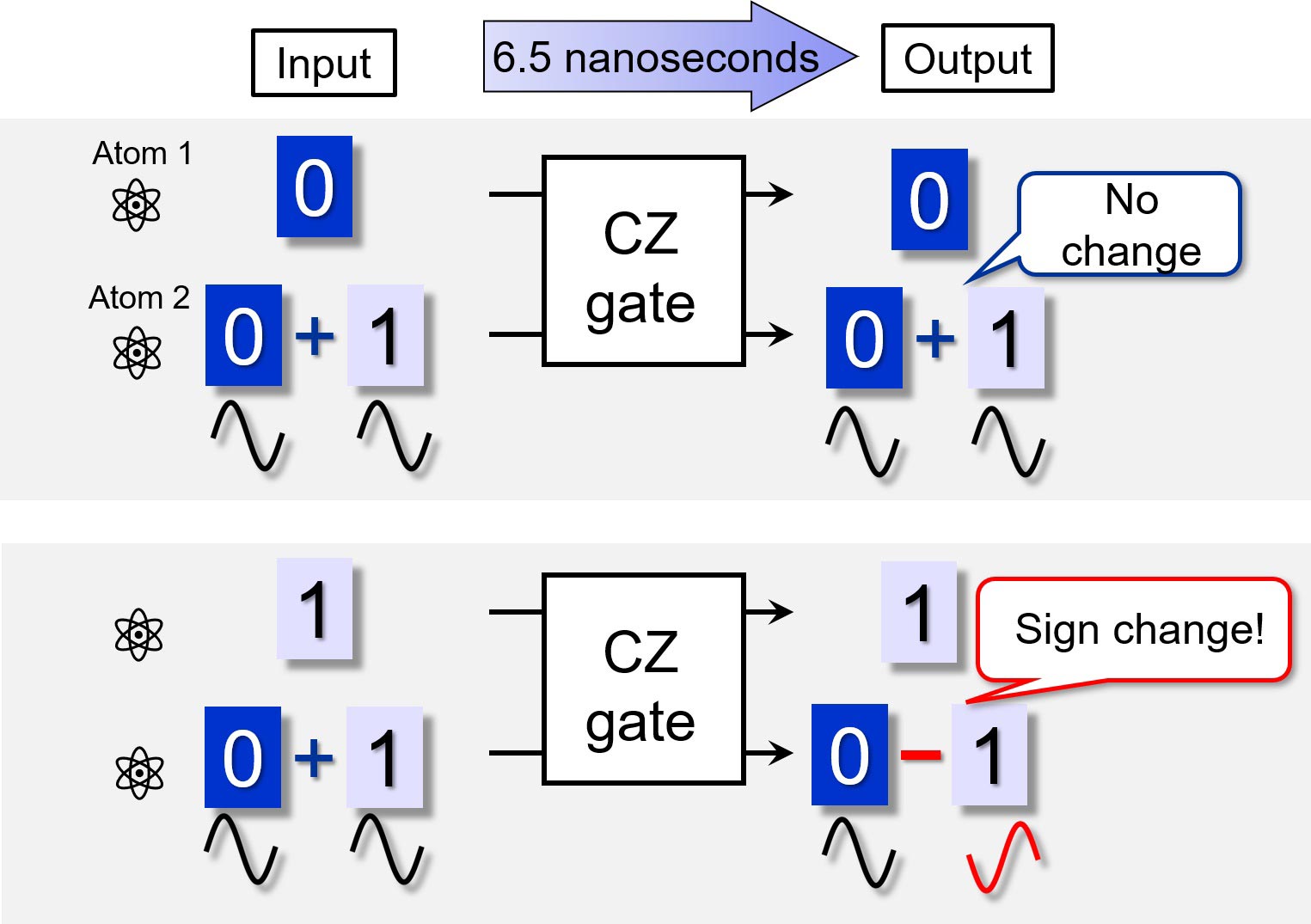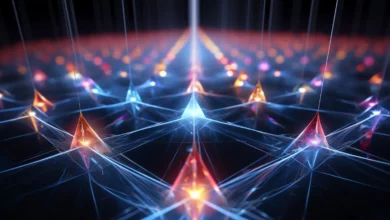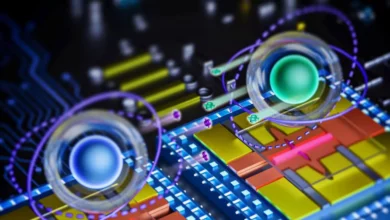
Figure 1. Conceptual diagram of the world’s fastest two-qubit gate. Two atoms captured in optical tweezers (red light) with a separation of a micrometer are manipulated by a ultrafast laser pulse (blue light) shone for only 10 picoseconds. Credit: Dr. Takafumi Tomita (IMS)
- A research team succeeded in executing the world’s fastest two-qubit gate (a fundamental arithmetic element essential for quantum computing) using a completely new method of manipulating, with an ultrafast laser, micrometer-spaced atoms cooled to absolute zero temperature.
- For the past two decades, all quantum computer hardware has been pursuing faster gates to escape the effects of external noise that can degrade computational accuracy.
- Cold-atom-based quantum computers are quickly attracting attention from industry, academia, and government around the world as revolutionary hardware that breaks through some limitations of superconducting and trapped-ion quantum computers, which are currently the most advanced types of quantum computers.
A research group is using atoms cooled to almost absolute zero[1] and trapped in optical tweezers[2] separated by a micron or so (see Figure 1). By manipulating the atoms with a special laser light shone for 10 picoseconds (pico = one trillionth of a second), they succeeded in executing the world’s fastest two-qubit gate,[3] see Figures 1 – 3, a fundamental operation essential for quantum computing[4], which operates in just 6.5 nanoseconds (nano = one billionth of a second). This ultrafast quantum computer,[4] which uses ultrafast lasers to manipulate cold atoms trapped with optical tweezers[2], is expected to be a completely new quantum computer hardware that breaks through the limitations of the superconducting and trapped-ion types currently in development.
The results will be published today (August 8, 2022) in the online edition of the British scientific journal Nature Photonics. The research team is led by graduate student Yeelai Chew, Assistant Professor Sylvain de Léséleuc and Professor Kenji Ohmori at the Institute for Molecular Science, National Institutes of Natural Sciences.

1 . Research background
1 – 1. Cold-atom based quantum computers:
Cold-atom quantum computers are based on laser cooling and trapping techniques celebrated by the Nobel Prizes of 1997 (S. Chu, C. Cohen-Tannoudji and W.D. Philipps, Cooling and trapping atoms with laser light) and 2018 (A. Ashkin, invention of the optical tweezers). These techniques, together with more recent breakthroughs in 2016, allows scientists to arrange arrays of cold atoms in arbitrary shapes with optical tweezers[2] and to observe each one individually.
Because atoms are natural quantum systems, they can easily store quantum bits of information. These are the basic building blocks “qubits” of a quantum computer (see Figure 2). In addition, these atoms being very well isolated from the surrounding environment and independent of each other, the coherence time (the time during which quantum superposition[5] persists) of a qubit can reach several seconds. A two-qubit gate[3] (an essential basic arithmetic element for quantum computing) is then performed by exciting one electron of the atom into a giant electronic orbital, called a Rydberg orbital.[6]
With these techniques, the cold-atom platform has emerged as one of the most promising candidates for quantum computer hardware. In particular, it has revolutionary potential in that it can be easily scaled up to a larger scale while maintaining high coherence compared to the superconducting and trapped-ion types that are currently being developed, and is attracting attention from industry, academia, and government around the world as the next generation of quantum computer hardware.

1 – 2. Quantum gates:
Quantum gates are the basic arithmetic elements that make up quantum computing. They correspond to the logic gates such as AND and OR in conventional classical computers. There are one-qubit gates that manipulate the state of a single qubit and two-qubit gates that generate quantum entanglement between two qubits. The two-qubit gate is the source of the high-speed performance of quantum computers and is technically challenging. The one successfully implemented this time is one of the most important two-qubit gates called a “controlled-Z gate (CZ gate),” which is an operation that flips the quantum superposition of a first qubit from 0 + 1 to 0 – 1 depending on the state (0 or 1) of a second qubit (see Figure 3). The accuracy (fidelity) of the quantum gate is easily degraded by noise from the external environment and the operating laser, which makes the development of quantum computers difficult. Since the time scale of noise is generally slower than one microsecond (micro = one-millionth of a second), if a quantum gate that is sufficiently faster than this can be realized, it will be possible to avoid the degradation of calculation accuracy due to noise, and we will be much closer to realizing a practical quantum computer. Therefore, for the past 20 years, all quantum computer hardware has been in pursuit of faster gates. The ultrafast gate of 6.5 nanoseconds (nano = one billionth of a second) achieved this time with the cold-atom hardware is more than two orders of magnitude faster than noise and thus can ignore the effects of noise. Incidentally, the previous world record was 15 nanoseconds, achieved by Google AI in 2020 with superconducting circuits.
2 . Research results
2 – 1. Summary of results:
The research group has used optical tweezers to trap two atoms cooled to nearly absolute zero and separated by only a micrometer. Then, they manipulated the atoms with a special laser beam that glows for only 10 picoseconds (pico = one trillionth of a second) and succeeded in executing the world’s fastest 2 qubit gate[3] (the basic arithmetic element essential for quantum computing), which runs in just 6.5 nanoseconds (nano = one billionth of a second). For the past 20 years, all quantum computer hardware has sought faster gates to escape the effects of external noise, which degrades the accuracy of calculations. The world’s fastest two-qubit gate achieved this time is more than two orders of magnitude faster than noise, making it possible to ignore the effects of noise. This ultrafast quantum computer, which uses an ultrafast laser to manipulate artificial crystals of cooled atoms aligned with optical tweezers, is expected to be a completely new quantum computer hardware that breaks through the limitations of the superconducting and trapped-ion types currently in development.
2 – 2. Experimental method (Figure. 1-3):
The experiment was conducted using rubidium atoms.[7] First, two rubidium atoms in the gas phase, which had been cooled to an ultra-low temperature of about 1/100,000 of a Kelvin[1] using laser beams,[8] were arranged at a micron interval with optical tweezers.[2] They then irradiated them with ultrashort laser pulses that emitted light for only 1/100 billionth of a second, and observed what kind of changes occurred. Two electrons trapped respectively in the smallest orbitals (5S) of two adjacent atoms (atom 1 and atom 2) were knocked into giant electronic orbitals (Rydberg orbitals, here 43D).[6] The interaction between these giant atoms then led to a periodic, back and forth, exchange of the orbital shape and electron energy occurring with a period of 6.5 nanoseconds. After one oscillation, the laws of quantum physics dictate that the sign of the wavefunction is flipped and thus realize the two-qubit gate (controlled-Z gate). Using this phenomenon, we performed a quantum gate operation using a qubit (Figure 2) in which the 5P electronic state is the “0” state and the 43D electronic state is the “1” state. Atoms 1 and 2 were prepared as qubits 1 and 2, respectively, and the energy exchange was induced using an ultrashort laser pulse. During one energy-exchange cycle (= 6.5 nanoseconds; nano = one billionth of a second), the sign of the superposition state of qubit 2 was reversed only when qubit 1 was in the “1” state (Figure 3). This sign flip was experimentally observed by the research group, thus demonstrating that a two-qubit gate can be operated in 6.5 nanoseconds, the fastest in the world.
3. Future development and social significance of this research
For the past 20 years, all quantum computer hardware has sought faster gates to escape the effects of external noise, which degrades the accuracy of calculations. The ultrafast quantum gates of 6.5 nanoseconds (nano = one-billionth of a second) achieved this time with the cold-atom hardware are more than two orders of magnitude faster than the noise and thus can ignore the effects of noise. The cold-atom quantum computer has revolutionary potential in that it can be easily scaled up to larger scale while maintaining high coherence compared to the superconducting and trapped-ion quantum computers that are currently being developed, and is attracting attention from industry, academia, and government around the world as the next generation of quantum computer hardware. The realization of the world’s fastest ultrafast gate, achieved this time by a completely new method of “manipulating two micron-spaced atoms cooled to almost absolute zero using an ultrafast laser,” is expected to greatly accelerate worldwide attention to cold-atom hardware.
4. Terminology
-
1. Absolute zero
- The temperature at which the motion of atoms and molecules has stopped is called absolute zero. The unit is Kelvin. Zero Kelvin is called absolute zero. An absolute temperature of 0 Kelvin is -273.15 degrees Celsius, and 0 degrees Celsius is an absolute temperature of +273.15 Kelvin.
-
2. Optical tweezers
- The optical tweezers were invented by A. Ashkin in the 1970s. It consists of a laser beam that is tightly focused to a size of less than a micrometer. Atoms are attracted to the bright focus and trapped there.
-
3. Two-qubit gate
- The two-qubit gate is the source of high-performance of quantum computers. It is a logical operation on the quantum state of two qubits. The two-qubit gate realized in this work, the “controlled-Z gate,” is an operation that changes the quantum superposition[5] of the first qubit from “0 plus 1” to “0 minus 1” when a second qubit is in state 1 (but not if in state 0). This “sign-flip” of the quantum superposition is a fundamental operation in quantum computers.
-
4. Quantum computer
- A computer that applies the properties of quantum superposition[5] to information processing. It performs information processing on a group of quantum systems, such as atoms, by manipulating their state (superposition of logical 0 and 1) and performing logical operations among multiple particles. By using the superposition property of quantum systems, it is expected that calculations that would take an ordinary computer a very long time can be performed much faster.
-
5. Quantum superposition
- In a classical computer, a bit (the unit of information) is either in state 0 or in state 1. The situation is much different in a quantum computer where a quantum object, such as an atom, can be in a superposition of two states: the atom being at the same time “in state 0 and in state 1”. Furthermore, there are many ways of superposing two states. Thinking of a quantum state as a wave, it becomes apparent that two waves can be superposed with their crest aligned (“state 0 plus state 1”) or with the crest of wave 1 aligned with the trough of wave 2 (“state 0 minus state 1”). See Figure 3.
-
6. Rydberg orbitals
- An electron orbital far from the atomic nucleus. In the experiment, the 43th orbital was used. This orbital is ~100 times larger than the 5th orbital. Electrons moving in Rydberg orbitals are called Rydberg electrons, and atoms with Rydberg electrons are called Rydberg atoms.
-
7. Rubidium atom
- An alkali metal atom with atomic number 37. It has one electron in the 5th orbital (5s) around the nucleus.
-
8. Laser cooling
- Laser cooling is a technique that uses laser light to remove energy from atoms and thus decrease their temperature. When an atom absorbs laser light, it receives the momentum of the laser photon and is subjected to a force in the direction of the laser light. If the atoms are traveling against the direction of the laser beam, the force gradually slows them down and lowers the energy of the atoms. This makes it possible to cool an atom down to about 1/100,000 of a Kelvin.[1]
Reference: “Ultrafast energy exchange between two single Rydberg atoms on the nanosecond timescale” 8 August 2022, Nature Photonics.
DOI: 10.1038/s41566-022-01047-2
Funding: Quantum Technology Flagship Program Q-LEAP, MEXT of Japan, Grant-in-Aid for Specially Promoted Research, JSPS, Humboldt Research Award, Alexander von Humboldt Foundation, and Heidelberg University





